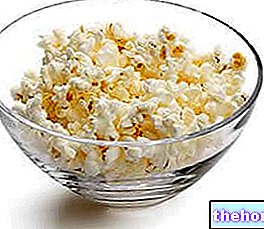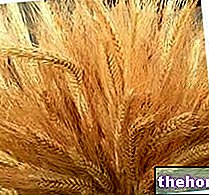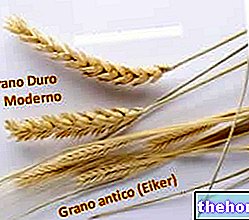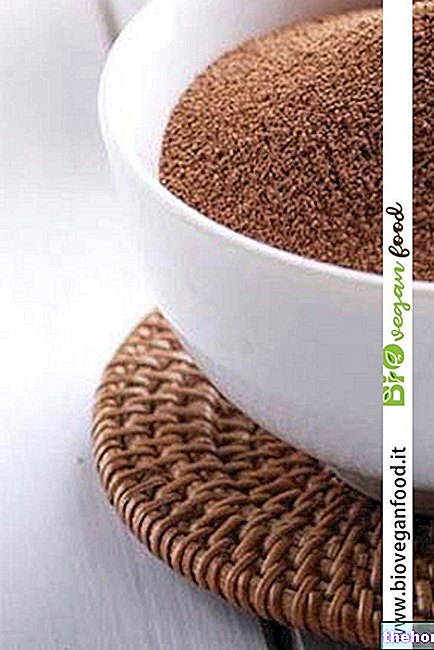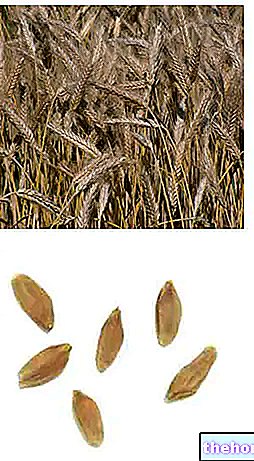Generality
Millet is a gluten-free cereal. It is a herbaceous plant belonging to the Graminaceae family (Poaceae), Genus Panicum, Species miliaceum; the binomial nomenclature of the mile is therefore Panicum miliaceum.

Description
The millet plant is herbaceous; it has a tendentially tender but rigid stem at the base, just before the roots. Millet is organized into different stems, leaves and flowers; generally it reaches the meter / meter and a half in height.
The leaves of the millet are tapered (maximum one centimeter wide), light green in color and tend to turn yellow only at the end of the life cycle. The flowers are organized in inflorescences similar to the "tuft" of corn, about 20cm long. Each inflorescence originates several small spikes (about 4cm) which house only a couple of flowers. From the flowers evolve the fruits (kernels, inside which the seeds proper are contained); this grain has a spherical and slightly elongated shape, while the color is basically greyish (light or dark). extremely low (about 7 times less than those of wheat).
Hints of cultivation
Millet does not require large quantities of water but requires a warmer climate than the average of cereals. It has an annual spring-summer cycle and sowing takes place, more or less, in the months of April or May, with harvesting after 120 days. . Millet is often used in the completion of annual cycles following winter crops; it does not require a particularly rich or fatty soil and medium - low levels of nitrogen and mineral salts are sufficient. When destined for human consumption, millet must be cut first fully ripe and left to dry before threshing. The millet yield is around 1-2 tons per hectare.
Origin
Today, the millet colonizes almost the entire planet. Thanks to its rusticity it easily adapts to many types of soil, as long as the climate is warm and / or temperate; also thanks to this characteristic, millet was one of the very first cereals to be exploited by man in agriculture.
The native lands of millet are still the subject of controversy but, in all likelihood, should be included in the Asian continent (India or the Middle East). It is not uncommon for millet to arise spontaneously in uncultivated land; it lends itself remarkably to arid or almost desert soils and constitutes one of the main food resources of the third world.
History
The millet has spread from its places of origin since prehistoric times, probably in conjunction with the great migrations. The archaeological finds dating back to the Stone Age place it in different areas of Asia and Europe (also in Italy), but only with the Roman age and even more in the Middle Ages did it become a primary source of livelihood for the population.
Like many other cereals, millet was also ousted from wheat crops (more profitable and predisposed to bread making). In the "Bel Paese", since the 14th century AD, a sort of thick soup (polenta) was prepared with millet; this took place long before the import of corn (100 years later) and the invention of the related Veneto-Friuli polenta (another 100 years later).
Today millet is considered a poor cereal and, as mentioned above, its cultivation is much inferior to that of wheat; in the old and new continents it is cultivated (in modest quantities) above all as a food source for certain small avian species.
Even in the sector of breeding intended for human consumption (meat, milk and eggs), millet is less productive than other cereals, however very cheap (eg corn and sorghum). Only in the driest areas of the globe, millet still directly (but partially) supports human nutrition.
The mile in the kitchen
Millet can be used like any other raw grain.
If boiled, it lends itself very well to the formulation of a "coarse polenta" (progenitor of corn polenta).
It is often present in mixed soups of cereals or cereals and legumes (also from organic farming) and there is no shortage of dietetic foods for celiacs based on pure millet or mixed with other mixed cereals. Like many other little-known products, the cereal is also among the ingredients of macrobiotic cuisine, vegan cuisine etc.
Millet can also be used to make "crunchy" sweets (with caramel). Traditionally, especially in African regions, millet flour is used for the production of foods similar to unleavened bread; even the whole seed, cooked naturally, is a typical first course of the aforementioned areas.
Millet can only be used in bread-making with added dietary foods (useful for leavening). The shelf-life of the NON-treated flour is rather short due to the good presence of oxidizable fatty acids.
Millet seeds can be found on the market both whole and hulled.
Cooking Ideas - Vegetarian gluten-free meatballs with millet and ricotta
Vegetarian balls with millet and ricotta
Problems with playing the video? Reload the video from youtube.
- Go to the Video Page
- Go to the Video Recipes Section
- Watch the video on youtube
Nutritional characteristics
First of all, millet is a cereal that does NOT contain gluten and lends itself to the "celiac diet. On the other hand, some argue that millet may contain molecules (perhaps) capable of compromising the synthesis of thyroid hormones; in the absence of more specific data, we will limit ourselves to taking this statement into consideration but always "with the benefit of the doubt" since, following heat treatment and digestion, most of the peptide, carbohydrate and lipid molecules (previously biologically active) should be demolished.
Millet has a rather high energy intake and is comparable to that of other dry cereals. The protein portion is deficient and the lipid portion, although greater than many others, is not particularly influential. The energy provided by millet comes mainly from complex carbohydrates.
The fiber content is remarkable; as far as vitamins and mineral salts are concerned, INRAN does not provide much detailed information; however, there are excellent contributions of iron and phosphorus.
Nutritional values
Nutritional composition for: 100g of Millet; 100g of hulled millet - Reference values of the INRAN Food Composition Tables

Other Cereals and Derivatives Amaranth Wheat starch Corn starch Rice starch Modified starch Oat starch Bulgur Whole grains Corn Flakes Crackers Oat bran Bran Cus cus Amaranth flour Oat flour Buratto flour Spelled flour Buckwheat flour Corn flour Corn flour Millet Barley flour Quinoa flour Small spelled flour (Enkir) Rice flour Rye flour Sorghum flour Flour and semolina Whole wheat flour Manitoba flour Pizza flour Spelled Rusks Focaccia Nuts Wheat or wheat Wheat germ Burnt wheat Buckwheat Breadsticks Oat milk Rice milk Corn Maizena Malt Millet Muesli Barley Stale bread Unleavened bread and Pita Bread Carasau bread Egg pasta Rice pasta Wholemeal pasta Piadina Small spelled Pizza Pop corn Baked goods Quinoa Rice Basmati rice Converted rice White rice Rice Wholemeal Parboiled Rice Puffed Rice Venus Rice Rye and Horned Rye Semolina Semolina Sorghum Spaghetti Spelled Teff Tigelle Triticale OTHER ARTICLES CEREALS AND DERIVATIVES Categories Food Alcoholics Meat Cereals and derivatives Sweeteners Sweets Offal Fruit Dried fruit Milk and derivatives Legumes Oils and fats Fish and fishery products Salami Spices Vegetables Health recipes Appetizers Bread, Pizza and Brioche First courses Second courses Vegetables and Salads Sweets and Desserts Ice creams and sorbets Syrups, liqueurs and grappas Basic Preparations ---- In the Kitchen with Leftovers Carnival Recipes Christmas Recipes Dietary Recipes Light Recipes Woman's Day, Mother's Day, Dad's Day Functional Recipes International Recipes Easter Recipes Recipes for Celiacs Recipes for Diabetics Holiday Recipes Valentine's Day Recipes Vegetarian Recipes Protein Recipes Regional Recipes Vegan Recipes

